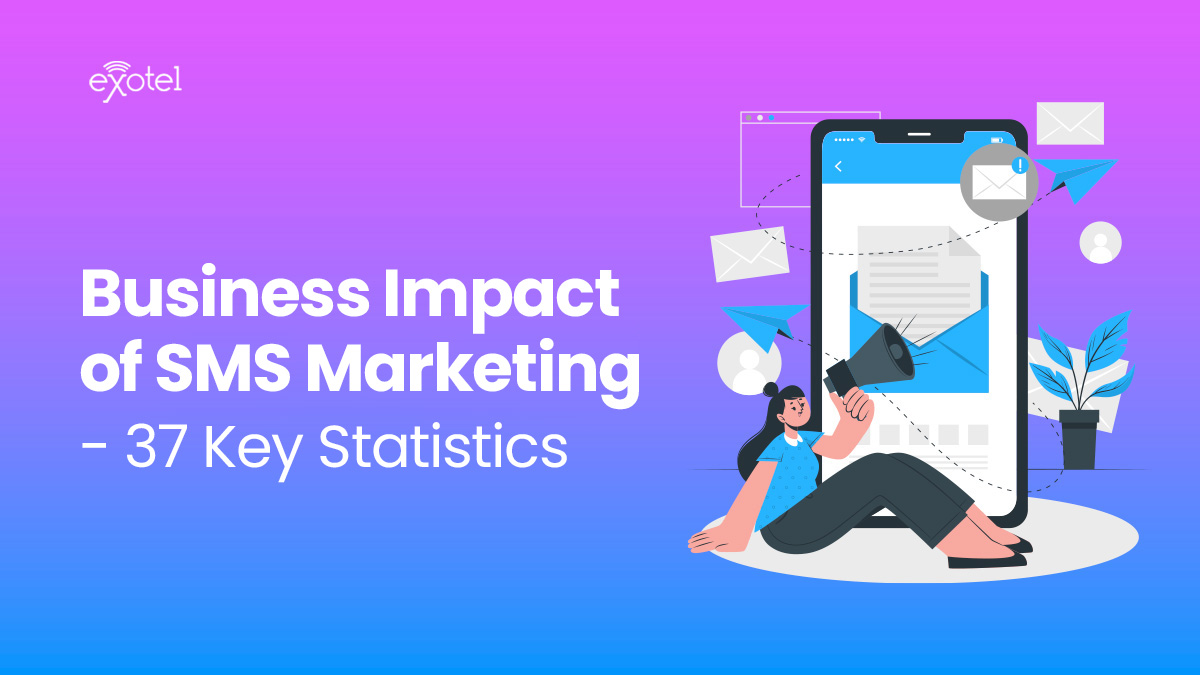SMS to Customers: To send or not to send?
This is one of the most common problems for marketing, customer service and operations leaders. Their decisions are often clouded by doubt, myths and fears around SMS marketing, its effectiveness, spam, compliance etc.
This blog post brings clarity to SMS marketing and text messaging. We list the top research-based statistics about texting to help you decide whether you need an SMS strategy, what messages to send, how, when and why you need them.

1. 5 billion people across the world own mobile phones
The GSMA mobile economy report finds that five billion people across the globe use mobile phones, over 50% of these on average using smartphones, connected to the Internet. (Source: GSMA report)
2. India will represent 35% of the next billion mobile connections
Meta, Facebook’s parent company, estimates that the next billion mobile connections will belong to Indians, representing a massive market for brands. (Source: Meta)
3. Only 24% of Indian mobile phone users have a smartphone
While cell phone adoption is growing rapidly in the Indian subcontinent, not all of them are smartphone users or Internet subscribers. Many still use their mobile phones for calls and SMS alone. (Source: GSMA report)
4. ~50% of Indian Internet users primarily consume content in a local language
Nearly half of the smartphone-using population consumes content in one of the 22 widely-spoken Indian languages. By looking beyond English-language communication, brands can reach a wider market across tier-2/3 cities and rural areas. (Source: Meta)
5. App-based text messaging is also growing rapidly
Last year, nearly half of all mobile phone users sent text messages through an over-the-top app. WhatsApp is the most used messaging app, while others, such as Telegram, Facebook messenger etc., are also gaining popularity. (Source: Statista)

6. Mobile phone users check their phones 96 times a day
Asurion finds that Americans check their phones once every ten minutes, a 20% increase from just two years ago. In addition, the demographic of 18-24 years of age checks their phone twice as much as the national average.
7. 67% of consumers check their phones within 5 minutes of waking up in the morning
The pandemic has brought customers closer to their cellphones, with 67% of users checking their phones within 5 minutes of waking up and 35% immediately. (Source: ZipWhip)

8. Indians spend 5 hours a day on their mobile
India saw 655 billion hours spent on mobiles in 2021, five hours a day for each mobile user. While a significant portion of this was on video, shopping etc., Indians spent about 19.8 hours every month on WhatsApp. (Source: App Genie)
9. Globally, mobile users prefer text over any other form of communication
Across all age groups, users prefer texting over talking. Even Baby Boomers, who are considered to be traditionally text unsavvy are 7x more likely to text than talk in person and are 2x as likely to send a text instead of calling. (Source: Asurion)
10. Millennials and GenZ in India prefer texting over voice and video calls
Preference for text messaging has snowballed since the pandemic among young Indians. In a study by Neilsen, 70% of respondents said that their chatting has increased in the last six months and will continue to do so. (Source: News18)
11. Teens love texting
88% of teens who use cell phones are intensive ‘text messagers’. Over 30% of teens send more than 100 messages a day or 3000 a month. (Source: Pew Research)
12. For the text-savvy audience, text is more than just text
The Neilsen study also revealed that millennials and GenZs regularly include emojis, stickers and GIFs while sending text messages.
13. Texters expect replies within 20 minutes; texting is instant!
Texters expect near real-time communication with SMSes. A Google study found that receivers feel pressured to respond to text “immediately or within a reasonable amount of time,” which can be as low as 20 minutes.
14. Even the elderly prefer SMS
Typically, mobile-based communication is a channel for the young population. However, a study by AARP Research finds that 50-69-year-olds prefer text messaging over email to stay connected.

15. 58% of customers prefer businesses to text them
When offered a choice between text, phone calls and emails, most customers say that text is the best way to reach them quickly. (Source: ZipWhip)
16. 65% of customers feel secure interacting with brands on SMS
85% of those surveyed by Klaviyo said that they had been contacted by a brand on SMS recently. And a majority of them felt safe with their interaction.
17. 52% of customers prefer text as their customer service channel
When the option is available, 52% of customers prefer text conversations over existing methods. (Source: HeyWire Business)
18. 31% say it is “important” for text as a customer support option
Even when organisations have a phone, email and social media as their customer support channels, nearly one-third of customers expect text-based support as an option. (Source: HeyWire Business)
19. 47% believe texting could improve customer satisfaction
Over three-fourths of customers are frustrated with existing customer support channels, with over half saying they had only ‘low’ to ‘fair’ satisfaction. In addition, 47% of customers say that texting could improve their overall satisfaction with customer support. (Source: HeyWire Business)
20. If you text them, they are more likely to choose you
Customers said that they are likely to choose a brand that sends them text messages across categories:
- 60% would instead schedule their hair care appointments via text
- 65% would rather use a financial service that communicated about accounts, bills and payment reminders
- 72% would rather book their travel with a company that communicated travel plans, reminders and updates via text message
- 70% would prefer a vacation rental manager texted them with updates and instructions
- 75% would choose a rideshare service by texting rather than calling when they arrived to pick them up
- 61% would recommend their friends switch to these companies. (Source: Avochato)
21. 63% would switch brands for text-based customer support
We’ve seen that customers prefer text as their customer support channel. But a majority of young customers admit that they are likely to switch service providers to offer text-based support. (Source: Avochato)
22. 69% of customers prefer unfamiliar companies to text them
Customers are more forgiving of unfamiliar brands when they text instead of call. 69% of them preferred to be texted by unknown companies. (Source: Avochato)
23. ~50% of customers are happy to make payments by text
Nearly half (46%) of consumers say they would like the option of paying a business by text if done securely. (Source: ZipWhip)
24. 45% of customers value two-way communication
Nearly half of respondents in a survey admitted that the ability to send SMSes back to brands is useful and adds weight to Forrester’s finding that “quantity of marketing messages has often trumped the quality.”
25. Customers will opt-in to SMS marketing for relevant messages
Flash sales, time-sensitive promotions, back-in-stock notifications and event reminders will likely inspire customers to sign up for SMS marketing. (Source: SimpleTexting)

26. Indians are receiving 1 billion SMSes each day
With the technology change, the average SMS sent daily has reached 1 billion. Businesses are hopeful that this will continue to grow. (Source: Economic Times)
27. Curbing spam-powered SMS growth
TRAI implemented a blockchain-led solution to weed out spam and fraud in March 2020, which resulted in a glitch, becoming a cause of concern about the new system. However, commercial SMS traffic has witnessed double-digit growth since then, with over 40 billion monthly SMSes. (Source: Financial Express)
28. Banking sends nearly 40% of all SMSes
The banking sector generates over 40% of SMS traffic. Most of these are transactional and OTP-based SMSes mandated by law. (Source: Financial Express)
29. BFSI, education and healthcare are top SMS senders
After banking and financial services, education and healthcare are India’s largest and fastest-growing SMS senders. (Source: Economic Times)
30. Retailers are increasing their SMS marketing budgets by 50%
Among all marketing channels, retailers are expected to increase investment in SMS marketing by 50%, even as they’re reducing budgets for other channels. (Source: Commerce Next)
31. 80% of customer service organisations will abandon native mobile apps in favour of messaging by 2025
In a dramatic u-turn, Gartner predicts that customer service organisations will abandon their efforts to build custom mobile apps for their brands and embrace messaging — SMS, WhatsApp, Facebook Messenger, WeChat etc. — more proactively.

32. 98% open rate; 45% response rate
SMSes perform much better than on all key performance metrics. For example, Gartner finds that the open rate for SMS is a massive 98%, while only 20% for email. In addition, the response rate for SMS is 45%, while a meagre 6% for email.
33. Click-through rates are also better with SMS
Click-through rates can be as high as 20-35% on SMS, compared to 10-20% on email. (Source: SimpleTexting)
34. Texting can boost sales by 328%
SMS also works effectively as a great follow-up and engagement channel. Leads360 found that sending three or more purposeful text messages to prospects can increase conversion rates by 328%.
35. SMS supports email marketing efforts
A follow-up SMS asking people if they’ve opened their email can help increase conversions significantly. Janna Land of direct-to-consumer (D2C) food retailer FarmFoods, Inc., said that after texting customers who had stopped engaging with their email marketing, they drove $4,000 of sales in less than 24 hours. (Source: eMarketer)
36. E-commerce makes most sales from SMS
Customers are less willing to look for deals on websites, emails, social media etc. They prefer that the deals directly come to them via SMS. This is why e-commerce businesses experience 98% open rates and 36% click-through rates. (Source: SimpleTexting)
37. SMS generates revenue
Almost all (96%) marketers using text messaging say it has helped drive more revenue. Nearly 60% say it has “significantly or overwhelmingly increased revenue generation.” (Source: AttentiveMobile)
If you’re still not convinced, see how Exotel has helped organisations across banking and financial services, education, e-commerce, logistics, healthcare, and IT transform their business with business SMS.
Read our case studies now.
 +91-808 8919 888
+91-808 8919 888 +91-808 8919 888
+91-808 8919 888 +966 135 181 912
+966 135 181 912



